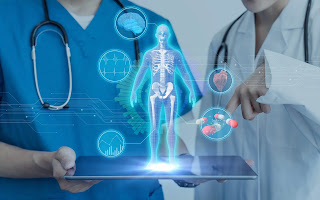- Get link
- X
- Other Apps
- Get link
- X
- Other Apps
 |
| Global Bio-imaging |
Bio-imaging technologies have revolutionised biomedical research by providing detailed insights into the structure and function of cells, tissues and whole organisms. Cutting-edge techniques allow researchers to peer inside living systems and gain a deeper understanding of health and disease. In this article, we explore the evolution of bio-imaging approaches and their widespread applications across the globe.
The Emergence of Modern Bio-imaging
Up until the 20th century, biologists were limited to microscopic
investigations of fixed and thinly sliced specimens. The development of
technologies like X-rays, electron microscopy and fluorescence opened new
windows into the interior of living samples. Groundbreaking inventions in the
latter half of the 20th century, such as computed tomography (CT), magnetic
resonance imaging (MRI) and positron emission tomography (PET), cemented
bio-imaging as a vital tool for biomedical sciences.
These early modalities focused on structural or anatomical data. Starting in
the 1980s, Global Bio-imaging probes
began to elucidate functional processes within cells and tissues in real-time.
Calcium indicators enabled researchers to visualize neuronal signaling and
muscle contraction. Advances in fluorescent proteins allowed dynamic
investigations of protein interactions and activity in living organisms. Modern
multi-modal systems have further enabled correlated structural and functional
analyses with high resolution and sensitivity.
Applications in Fundamental Cell and
Molecular Biology
Bio-imaging finds widespread applications in basic cell and molecular biology
research. Fluorescence microscopy is a mainstay for examining the dynamics of
intracellular structures, protein localization and cell behavior. Advances like
super-resolution techniques are pushing boundaries to resolve nanoscale
cellular architecture and movements. Live-cell imaging has given unprecedented
views of processes like mitosis, gene expression, cell migration and protein
trafficking.
Imaging mass spectrometry allows molecular identification within tissue
sections without labeling. Crystallography and electron microscopy provide
exquisite structural information on molecular complexes and organelles down to
the atomic level. Multi-photon and light-sheet microscopes enable
high-throughput 3D analysis of complex in vivo models. Overall, bio-imaging has
been instrumental in characterizing biological structures, elucidating
signaling pathways and gaining new insights into health and disease.
Translating Discoveries to the Clinic
Exciting developments in bio-imaging are directly impacting patient care
through translational medicine applications. Advanced MRI and PET scans provide
sensitive, non-invasive diagnostics for conditions like cancer, cardiovascular
disease and neurological disorders. Optical methods like fluorescence molecular
tomography enable whole-body, 3D assessment of disease processes in small
animal models to accelerate therapeutic development.
Intraoperative imaging modalities continue to push the boundaries of minimally
invasive surgery. Confocal microscopes now guide brain surgeons in real-time.
Raman spectroscopy and optical coherence tomography are enhancing cancer
detection and margin analysis during operations. Novel probes also allow
imaging-guided therapies through non-invasive targeted drug delivery,
photodynamic tumor destruction and high intensity focused ultrasound ablation.
International Collaboration Driving
Innovation
To tackle grand biomedical challenges, bio-imaging research has become highly
collaborative on a global scale. Major international projects have supported
technology development, shared open-access datasets and best practices. For
example, the Human Connectome Project and the Blue Brain Project aim to comprehensively
map neural circuits and brain structure-function relationships.
The Bio-Imaging Network in Europe coordinates initiatives across 24 countries.
The Brain Research through Advancing Innovative Neurotechnologies (BRAIN)
Initiative in the US fosters partnerships to revolutionize understanding of the
brain. Key Asian consortia like India's Bioimaging Network and China's National
Laboratory of Biomacromolecules support collaborative imaging science.
International synergy will be critical to realize the full potential of
bio-imaging to transform healthcare worldwide.
The Future of Global Bio-Imaging
With continuous innovation, the once boundaries of bio-imaging resolution,
sensitivity and scale are being constantly pushed. Novel contrast agents,
activation probes and reporters are enhancing functional specificity.
Multimodal fusion promises comprehensive multi-parametric views of biological
systems. Advanced computational analytics and machine learning will extract
deeper insights from complex imaging datasets.
Next-generation technologies like light-sheet microscopes, cortical sheet
imaging and volume electron microscopy promise whole-organ and whole-body
visualization with nanoscale detail. Novel applications may enable non-invasive
early disease detection, real-time image-guided interventions and
individualized assessments of treatment responses. Widespread integration of
bio-imaging into research and clinics worldwide holds immense promise to
advance human health and longevity. With international collaborations, the
future of bio-imaging as a global enterprise remains bright.
Get
more insights on Global Bio-Imaging
- Get link
- X
- Other Apps
Comments
Post a Comment